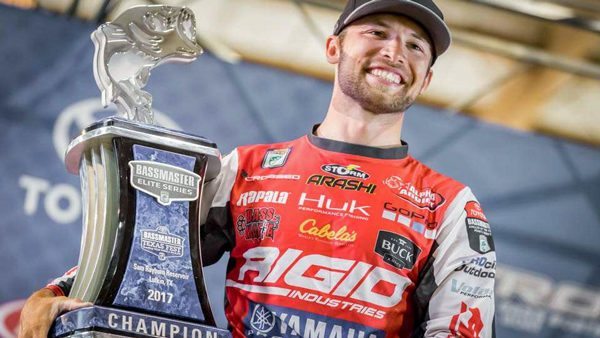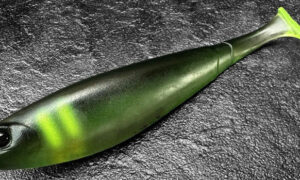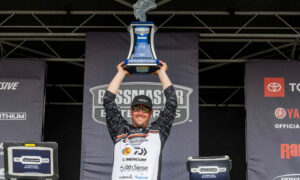
Brandon Palaniuk didn’t know it, but he had the Rayburn Texas BASSFest — or whatever it’s called — won. Because he had his fish found while the only other guy within range, Brent Ehrler, was making something out of nothing. Here’s how BP did it.
Practice
> “I really on got on them during practice but didn’t know what I was on. At the same time, I don’t think [what he found] was as good in practice as it became during the tournament.
> “What I figured out was the big ones had not made the full transition to their main summertime stuff yet. I think a lot of guys missed that who fished out deep. I idled the typical ledges, creek channels, ends of points and humps — they had schools, but they were 1.5- to 2-lbers. The big ones weren’t there.
> “The big ones were singles or doubles, not big schools. I figured out they were sitting in brushpiles or standing timber with a bottom composition change — they were relating to the bottom composition [mud to hard bottom] but were suspended in the timber. They also had to be on a straight bank — not the tip of a point, but a straight bank leading from a spawning area out to that point. It was a midway transition point.”
Dialing in
> “A lot of those standing-timber fish were sitting in 18-28′ suspended 5-6′ up off the bottom. They were relating to the bottom composition change even though they weren’t sitting on the bottom.
> “I caught fish from 4′ to 30′. That sounds crazy, like it’s not narrowed down at all — it’s just I felt like the fish were spread out so far. But the same principles applied to all depths of the water column: It had to have that straight, steeper edge. Whether I was fishing grass or was way out there, I needed to have that good, straight edge that was close to a main channel. Main-lake fish were close to the main river channel, and grass fish were close to a creek channel.
> “The best shallower stuff I had was where the grass almost matted up to the surface, and slowly fell off to a straight wall. The fish would roam and sit on the edge for an ambush point.
> “I was paralleling those edges, keeping the bait in the strike zone the longest.
> “I had one bank close to a lot of deep stuff that was really unique. It had a little rock that created an underwater bluff. It was a flat in 2′ that dropped straight down to a 6′ shelf, then dropped into the channel. Some boulders had fallen off it making almost a natural riprap bank [under the] surface. The fish were holding by the bigger boulders.”
Baits

Every day he fished the same topwater shallow, and a soft-plastic deep: Days 1-2 it was a Neko rig, and days 3-4 it was a Texas rig.
> Topwater: #13 size Storm Arashi Top Walker (pro blue, stock hooks), 40-lb Seaguar Smackdown braid, 6′ 10″ M Alpha Angler Slasher rod. “When you’re throwing braid, something has to give so that rod has a really good tip to walk that bait — it creates a ton of action but has enough backbone fight big fish and the right bend to keep them pegged.”
> Neko rig: Zoom Magnum Trick Worm (gp), 1/0 weedless VMC Neko hook [weedless version coming out at ICAST], 3/16-oz VMC Half Moon Wacky Weight, 15-lb Smackdown braid, 10-lb Seaguar Tatsu leader, 7′ M Alpha Wrench spinning rod.
> He said he caught “all the giants” on the Neko rig, but lost giants too. “I just knew [losing fish] was going to be part of what I was fishing — it was such nasty cover. It was kind of an odd game of getting more bites and hopefully landing the majority of them. I had an 8-04 stuck in a tree for 3 minutes.”
> He fished it “in and around brushpiles, and flipped it to the isolated trees that the fish were sitting in. On my 360 I could see fish suspended around standing timber — I would specifically target the trees I saw the fish in.”
> Why a Neko rig: “In practice I was marking fish I swore I knew were bass. I was throwing big cranks, football jigs — but I wasn’t getting bit. So just to figure out if they were bass, I dropped the Neko rig — and the first fish I caught was a 9+. So that told me what I was looking at were bass, and there might be something to that Neko rig. When I kept it in my hand, I could go to every single brushpile and catch one.”
> He’d never fished a Neko rig in a tournament before.
> Texas rig: 10″ Zoom Ol’ Monster Worm (plum), 1/2-oz VMC Tungsten Flipping Weight, VMC Sinker Stop, 5/0 VMC Heavy Duty Wide Gap Hook, 15-lb Seaguar InvizX (17-lb the final day), 7′ 3″ MH Alpha Angler Zilla rod.
> “I would start with that in the brushpiles just because the heavier line and bigger hook upped the odds of landing them.”
More
> Water clarity and temp didn’t seem to matter much.
> “The first 3 days I was super-calm and relaxed — no pressure. The last day felt like the most intense final day I’ve had yet. I really wanted to win this one bad. It’s been so long…I know it’s only been 4 years, and I know guys have gone a lot longer than that without a win. But I set a goal to win one every 2-3 years, and when don’t meet my goals it makes me angry.”



























